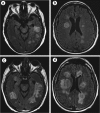Clinical and morphologic findings in disseminated Scedosporium apiospermum infections in immunocompromised patients
- PMID: 24982580
- PMCID: PMC4059584
- DOI: 10.1080/08998280.2014.11929129
Clinical and morphologic findings in disseminated Scedosporium apiospermum infections in immunocompromised patients
Abstract
Scedosporium apiospermum is a ubiquitous, saprophytic, filamentous mold that may cause localized, subcutaneous infections in immunocompetent hosts, but disseminated infection in severely immunocompromised patients. This mold is often highly resistant to multiple commonly used antifungal drugs. Even with treatment, there is a high mortality rate. We present two patients with fatal disseminated S. apiospermum infections after bone marrow and lung transplantation. This infection can be rapidly fatal, and survival may be improved by early recognition.
Figures




References
-
- Husain S, Muñoz P, Forrest G, Alexander BD, Somani J, Brennan K, Wagener MM, Singh N. Infections due to Scedosporium apiospermum and Scedosporium prolificans in transplant recipients: clinical characteristics and impact of antifungal agent therapy on outcome. Clin Infect Dis. 2005;40(1):89–99. - PubMed
-
- Tortorano AM, Richardson M, Roilides E, van Diepeningen A, Caira M, Munoz P, Johnson E, Meletiadis J, Pana ZD, Lackner M, Verweij P, Freiberger T, Cornely OA, Arikan-Akdagli S, Dannaoui E, Groll AH, Lagrou K, Chakrabarti A, Lanternier F, Pagano L, Skiada A, Akova M, Arendrup MC, Boekhout T, Chowdhary A, Cuenca-Estrella M, Guinea J, Guarro J, de Hoog S, Hope W, Kathuria S, Lortholary O, Meis JF, Ullmann AJ, Petrikkos G, Lass-Flörl C. ESCMID and ECMM joint guidelines on diagnosis and management of hyalohyphomycosis: Fusarium spp., Scedosporium spp. and others. Clin Microbiol Infect. 2014;20(Suppl 3):27–46. - PubMed
-
- Riddell J, 4th, Chenoweth CE, Kauffman CA. Disseminated Scedosporium apiospermum infection in a previously healthy woman with HELLP syndrome. Mycoses. 2004;47(9–10):442–446. - PubMed
-
- Marco de Lucas E, Sádaba P, Lastra García-Barón P, Ruiz Delgado ML, Cuevas J, Salesa R, Bermúdez A, González Mandly A, Gutiérrez A, Fernández F, Marco de Lucas F, Díez C. Cerebral scedosporiosis: an emerging fungal infection in severe neutropenic patients: CT features and CT pathologic correlation. Eur Radiol. 2006;16(2):496–502. - PubMed
Publication types
LinkOut - more resources
Full Text Sources
Other Literature Sources
